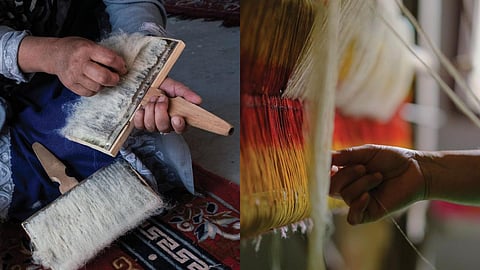
- HOMEGROWN WORLD
- #HGCREATORS
- #HGEXPLORE
- #HGVOICES
- #HGSHOP
- CAREERS
- ABOUT US
- CONTACT US

Cashmere wool — or simply Cashmere — gets its name from the Kashmir region, where the fibre was first produced and used to make yarn, textiles, and warm clothing. In its raw form, the fibre is collected from the fine, soft downy undercoat of Kashmir goats found in the high mountains of North India and Central Asia where its known as 'Pashm' or 'Pashmina'. These goats moult their coat annually, and the fine undercoat is collected by hand, dyed, and spun into luxuriously soft yarn by skilled artisans following a laborious collection, separation, and spinning process. Each Kashmir goat produces around only 100 to 200 grams of cashmere each year, making the fibre a highly sought-after rarity in the world of luxury fashion. To put the rarity of cashmere wool in perspective, a single medium-sized sweater requires the entire annual yield of between three to five Kashmir goats.
In the 16th century, fine shawls spun by Kashmiri craftsmen and traded on the Silk Route became popular among European nobility as ‘cashmere shawls’ and gave the fibre its name. By the 18th century, these shawls were being exported to the West, reaching the royal courts of Britain and France. Supposedly, Empress Josephine — the first wife of Napoleon Bonaparte — had hundreds of cashmere shawls in her collection. Today, cashmere is still considered a rare luxury fibre for its incredible softness, impressive warmth-to-weight ratio, and longevity when cared for properly.
In Kashmir — its home terrain — however, the soft, fine, luxury Pashmina fibre has fallen out of favour because of socio-political turmoil as well as the low yield and the long time it takes to collect and process the fibre to make yarn, textiles, and clothing. This is where Looms of Ladakh comes into play. Founded by social entrepreneur Abhilasha Bahuguna and her husband Prasanna Ramaswamy G. — the former Deputy Commissioner of Leh — in 2017, the herder-and-artisan-led farm-to-fashion collective brings modern designs to the heritage pashmina craft. Situating itself at the intersection of luxury fashion and cultural heritage conservation, the brand upskills traditional pashmina artisans and enables them to earn a fairer price for their craftsmanship.
In recent years, Looms of Ladakh has also tied up with other brands and organisations to amplify these local communities, boost their local economy, and promote their handmade, naturally dyed textile products. 'The Himalayan Knot' is one such collaborative effort between Looms of Ladakh and Royal Enfield to bring together these communities, conservation specialists, craftspeople, and designers to conserve pastoral land and safeguard the living heritage for future generations.
In 2022, as part of this ongoing collaboration, Looms of Ladakh and Eka Design Studio came together and launched three capsule collections of textile products made with the wool of Changthangi sheep which allowed the Ladakhi women artisans associated with Looms of Ladakh to expand the scope of their traditional Pashmina craft.
Today, the collective’s operations are spread across 16 villages across two districts of Ladakh, with over 400 women from different self-help groups participating in the project. Together, they are reclaiming the forgotten heritage of the region's handspun and naturally dyed pashmina textile tradition — one yarn at a time.
Follow Looms of Ladakh here.
If you enjoyed reading this, here's more from Homegrown:
PARA Design Studio Is Preserving The Past Through Sustainable & Thoughtful Renovation
A Homegrown Studio Is Making Sustainable & Design-Forward Furniture Out Of Mushrooms
How Helena Bajaj Larsen Is Paving A Bold New Path For Homegrown Textile Art & Design
